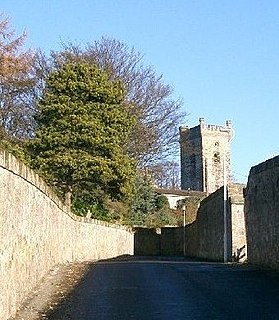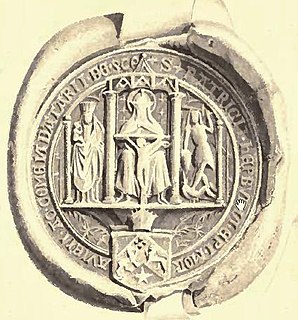See also
Senior churchmen of Medieval Scotland (post-1100) | |
|---|---|
| Archbishops | |
| Bishops | |
| Archdeacons | |
| Abbots | |
| Priors | |
| This article related to religion in Scotland is a stub. You can help Wikipedia by expanding it. |
The Prior of Blantyre (later Commendator of Blantyre) was the head of the medieval community of Augustinian canons based at Blantyre Priory (in modern South Lanarkshire). It was founded between 1239 and 1248, but the first prior is not known by name until 1296. Few of the priors are known thereafter until records become more extensive in the 16th century. The following is a list of known priors and commendators:
| This article related to religion in Scotland is a stub. You can help Wikipedia by expanding it. |
The Abbot of Paisley was the head of the Cluniac monastic community of Paisley Abbey and its property. The monastery was founded as a priory at Renfrew in 1163, but moved to Paisley in 1169. It became an abbey in 1219. The founder was Walter fitz Alan, Seneschal (Steward) of Scotland. The line of abbots ended when it was turned into a secular lordship for Lord Claud Hamilton in 1587/1592. The following is a list of abbots and commendators:
The Abbot of Kelso was the head of the Tironensian monastic community at Kelso Abbey in the Scottish Borders. Originally, he was the Abbot of Selkirk, because from its foundation in 1113 by David, Prince of the Cumbrians (1113–1124) until it was moved to Kelso by David and John, bishop of Glasgow in 1127. The abbot was the first in Scotland to be granted the mitre in 1165. In the 16th century the monastery increasingly came under secular control, and finally in 1607 it was granted as a secular lordship (Holydean) to its last commendator, Robert Ker of Cesford, later earl of Roxburghe. The following is a list of abbots and commendators:

The Abbot and then Commendator of Culross was the head of the monastic community of Culross Abbey, Fife, Scotland. The abbey was founded in 1218 on the patronage of Maol Choluim I, Earl of Fife by Cistercian monks from Kinloss Abbey, Moray. Control of the abbey was secularized in the 16th century and after the accession of James Stewart, the abbey was held by commendators. The number of monks under the abbot had also declined by the 16th century, there being only 15 monks by 1557.

The Abbot of Arbroath or Abbot of Aberbrothok was the head of the Tironensian Benedictine monastic community of Arbroath Abbey, Angus, Scotland, founded under the patronage of King William of Scotland from Kelso Abbey and dedicated to St Thomas of Canterbury, Thomas Becket. The abbot, John Gedy, was granted the mitre on 26 June 1396. Arbroath Abbey became the wealthiest and most powerful abbey in later medieval Scotland.

The Abbot of Inchaffray, before 1221 Prior of Inchaffray, and then by the end of the 15th century, the Commendator of Inchaffray, was the head of the community of Augustinian canons of Inchaffray Abbey and their lands. Inchaffray is in Strathearn, in southern Perthshire, Scotland. The house was founded by Gille Brigte (Gilbert), mormaer of Strathearn in 1200 as a priory and was elevated to an abbey in 1221. By the late 15th century the monastery was becoming secularized. and after the resignation of Abbot George Mureff (Murray) in 1495, Laurence, Lord Oliphant, took over as commendator and thereafter it was held by commendators. It was turned into a secular lordship for Commendator James Drummond, Lord Maddertie, but the final formalization of the lordship did not come until 1669, when the it was given to William Drummond.
The Prior of St Andrews was the head of the property and community of Augustinian canons of St Andrews Cathedral Priory, St Andrews, Fife, Scotland. It was established by King David I in 1140 with canons from Nostell Priory, West Yorkshire. It is possible that, initially at least, the prior of St Andrews was subordinate to the bishop as abbot, but by the 13th century the canons of St Andrews were given freedom by the bishop to elect their prior. By the end of the 13th century, the abbacy of the native canons was no longer there to challenge the position of the priory, and the native canons themselves had been formed into a collegiate church.
The Abbot of Kilwinning was the head of the Tironensian monastic community and lands of Kilwinning Abbey, Cunningham, founded between 1162 and 1167. The patron is not known for certain, but it is likely to have been Richard de Morville, Lord of Cunningham. The following are a list of abbots and commendators.
The Prior of Restenneth was the head of the Augustinian canons of Restenneth Priory, Angus. The following is a list of priors and commendators:
The Abbot of Jedburgh was the head of the Augustinian canons of Jedburgh Abbey, Roxburghshire. It was founded by King David I of Scotland in 1138, and David's grandson and successor Máel Coluim IV ensured its promotion to the status of abbey before 1156. The position was secularized in the 16th century, and in 1606 turned into a secular lordship for the last commendator, Alexander Home, now earl of Home.
The Abbot of Newbattle was the head of the Cistercian monastic community of Newbattle Abbey, Midlothian. It was founded by David I of Scotland in 1140.
Prior of Monymusk was the head of the property and community of Augustinian canons of Monymusk Priory, Aberdeenshire. The following is a list of priors and commendators:
The Prior of St Mary's Isle was the head of the Augustinian monastic community of St Mary's Isle Priory, in Kirkcudbrightshire, Galloway. The following is a list of priors and commendators:
The Prior of May then Prior of Pittenweem was the religious superior of the Benedictine monks of Isle of May Priory, which later moved to the mainland became called Pittenweem Priory. The priory was originally based on the Isle of May, but was moved by 1318 to its nearby mainland site of Pittenweem, Fife, passing from the overlordship of Reading Abbey (Benedictine) to St Andrews Cathedral Priory (Augustinian). The following is a list of priors and commendators:
The Prior of Coldingham was the head of the Benedictine monastic community of Coldingham Priory in Berwickshire. Coldingham Priory was founded in the reign of David I of Scotland, although his older brother and predecessor King Edgar of Scotland had granted the land of Coldingham to the Church of Durham in 1098, and a church was constructed by him and presented in 1100 AD. The first prior is on record by the year 1147, although an earlier foundation is almost certain. The monastic cell was a dependent of Durham until the 1370s, and in 1378 King Robert II of Scotland expelled the Durham monks; for the following century the cell had two priors, one chosen by Durham and one chosen by the Scots. It became a dependent of Dunfermline Abbey. It was subject to increasingly secular control from the late 15th century into the 16th century. The following is a list of priors and commendators:
The Prior of Pluscarden was the head of the monastic community and lands of Pluscarden Priory, Moray, Scotland. The Priory was founded in 1230 by King Alexander II of Scotland for the Valliscaulian Order. In March 1454 it incorporated the foundering neighbouring establishment of Urquhart Priory and became a dependency of Dunfermline Abbey, whence it became Benedictine. The following are a list of abbots and commendators:
The Prior of Ardchattan was the head of the Valliscaulian, and then Cistercian, monastic community of Ardchattan Priory, Argyll. It was founded in 1230 by Duncan MacDougal, Lord of Argyll. In April 1510 it was incorporated as a cell of Beauly Priory. It was annexed to the bishopric of the Isles in 1615. The following are a list of abbots and commendators:

Patrick Hepburn was a 16th-century Scottish prelate. He was born in East Lothian, went to St Andrews University, entered the church, and then exploited his family connections to become Prior of St Andrews and royal secretary. Hepburn moved on to become Bishop of Moray and Commendator of Scone and played an ambiguous role in the Scottish Reformation. During this time he held a notorious reputation for immorality. He was deprived of his ecclesiastical titles two years before his death in 1573.

Perth Charterhouse or Perth Priory, known in Latin as Domus Vallis Virtutis, was a monastic house of Carthusian monks based at Perth, Scotland. It was the only Carthusian house ever to be established in the Kingdom of Scotland, and one of the last non-mendicant houses to be founded in the kingdom. The traditional founding date of the house is 1429. Formal suppression of the house came in 1569, though this was not actualised until 1602.
The Prior of Perth was the head of Perth Charterhouse, the Carthusian monastic house located near Perth. It was founded ion 1429, and finally suppressed in 1602. The following is a list of priors and prior-commendators: